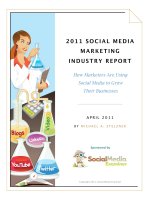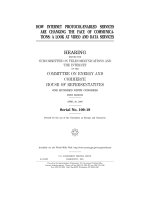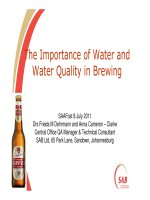Using Social Media and Internet Data for Public Health Surveillance The Importance of Talking
Bạn đang xem bản rút gọn của tài liệu. Xem và tải ngay bản đầy đủ của tài liệu tại đây (82.78 KB, 6 trang )
Commentary
Using Social Media and Internet Data for
Public Health Surveillance: The Importance
of Talking
DAVID M. HARTLEY
Georgetown University Medical Center
It doesn’t have to be like this. Our greatest hopes could become reality
in the future with the technology at our disposal. The possibilities
are unbounded. All we need to do is make sure we keep talking.
—Stephen Hawking
1
D
espite progress in public health and the
biomedical sciences, infection has yet to be vanquished:
vaccine-preventable diseases continue to be transmitted;
pandemics occur; previously unknown pathogens emerge; contaminated
foods and food products are traded and consumed; and the specter of a
post-antibiotic era looms ever larger. Bioterrorism is, and will remain,
a danger. Infectious disease is both a national and an international
security issue and represents an important threat to human health and
well-being.
In order to confront these and related threats, detailed data regarding
the global ebb and flow of disease are needed. Over many decades, surveil-
lance methods (often termed “indicator-based” methods) have been de-
veloped and refined to provide disciplined, standardized approaches to
acquiring and recording important information. More recently, ubiqui-
tous and unstandardized data collected from the Internet have been used
to gain insight into emerging disease events. Although this approach—
known as “Internet-based biosurveillance,” “digital disease detection,”
or, more simply, “event-based” surveillance—has been described and
Address correspondence to: David M. Hartley, Department of Microbiology and
Immunology, 2115 Wisconsin Ave NW, Suite #603, Washington, DC 20057
(email: ).
The Milbank Quarterly, Vol. 92, No. 1, 2014 (pp. 34-39)
c
2014 Milbank Memorial Fund. Published by Wiley Periodicals Inc.
34
Using Social Media and Internet Data for Public Health 35
analyzed in the literature,
2-4
systematic reviews of the field have been
few.
It is this intellectual gap that makes the article by Edward Velasco and
his coworkers in this issue of the Quarterly so valuable and timely. Velasco
and his colleagues systematically searched for and reviewed more than
20 years of published studies of event-based systems and approaches,
providing a much-needed perspective on both research in the field and
several important issues. After selecting relevant peer-reviewed studies
to include in their analysis, they extracted the attributes of 13 dif-
ferent event-based systems. They then defined 15 different descriptive
attributes that capture the principal facets of event-based systems, in-
cluding the languages and types of diseases systems covered, the methods
by which each system produces its output, and the types of users that
each system attracts. Such metrics are necessary for comparing and con-
trasting different approaches to event-based surveillance. Readers should
bear in mind that the properties and lifetimes of these systems are dy-
namic, as is the Internet itself, and that technologies and methodologies
change rapidly, allowing systems to improve and evolve over weeks or
months. Accordingly, one of the key contributions of Velasco and col-
leagues’ study is the set of metrics they propose, in which event-based
systems can be tracked over time in order to quantitatively understand
how much event-based biosurveillance has changed and continues to
change.
Velasco and colleagues seek to provide a basis for public health agen-
cies incorporating event-based methods into existing, comprehensive
surveillance programs, and they cite user confidence in this approach as
an important step in this process. Their review of the literature, how-
ever, uncovered no event-based systems that were regularly incorporated
into national programs for surveillance during their study period (1990-
2011). Moreover, they found no comprehensive evaluations showing
whether or not these systems had been deployed during real-time health
events.
Although this evidence may be lacking in the peer-review lit-
erature included in their study, there is evidence that several sys-
tems are utilized, to varying extents, by national and international
public health organizations. At the international level, for exam-
ple, the World Health Organization (WHO) uses the Canadian-
based Global Public Health Intelligence Network in its global alert
36 D. M. Hartley
and response activities.
5
The European Centre for Disease Prevention
and Control utilizes the MedISys system ( />homeedition/en/home.html),
4
and a recent study described the
evaluation of several event-based systems by international public health
professionals.
6
At a national level, the US Centers for Disease Control
and Prevention (US CDC) utilize event-based data,
7
and at the local
level, a social media–monitoring program known as Foodborne Chicago
is being used to monitor foodborne diseases.
8-9
Because the informa-
tion from the WHO,
5
the US CDC,
7
and Foodborne Chicago
8
are web
pages or newspaper stories published after the study period,
9
rather than
peer-reviewed studies produced during the study period, Velasco and
colleagues did not include them. This is less a criticism than an illus-
tration of how quickly event-based data are evolving and of why such
information is not necessarily wholly contained in the research litera-
ture. Consequently, it will be critical for future studies to include public
media and non-peer-reviewed sources in their assessments of event-based
data systems.
Of course, a broader question is that regardless of how many public
health workers are currently using these systems, what is preventing
them from being utilized more broadly and effectively? Here, the ap-
proach used in a recent work by Barboza and colleagues is instructive.
6
They asked respondents to rate, on a uniform scale, the usability and
relative strengths of several event-based systems. The results high-
lighted the complementarity of different systems and demonstrated
the value of using multiple systems to produce the most robust re-
sults from the event-based approach. In combination, that study and
the work by Valasco and colleagues underscore the importance of
consulting stakeholders in the design and refinement of event-based
surveillance systems. Accordingly, an assessment of stakeholder en-
gagement would be a useful metric to include in future systematic
reviews.
Velasco and colleagues discuss the limitations of event-based systems
as well, such as (1) information is not always moderated by professionals
or interpreted for relevance before it is disseminated to interested surveil-
lance epidemiologists; (2) there is no standardized system for updates,
often resulting in too much information; (3) algorithms and statistical
baselines are not well developed; and (4) new information related to
Using Social Media and Internet Data for Public Health 37
health events or probable cases is not always disseminated in the most
efficient way. These limitations point to two vital issues.
First, different users have different needs. Some need to see every-
thing reported by event-based surveillance systems (ie, although they
are not concerned about specificity, they are concerned about sensitivity),
whereas other users may demand low false-alarm rates (ie, specificity is
important to their needs). Put another way, some users are more in-
terested in early warnings of threats, so they need to examine all in-
dications of an emerging event. Others, however, are more interested
in the situational awareness of identified threats. Thus, interpreting
Valasco and colleagues’ findings in the context of diverse users’ needs is
paramount.
10,11
Second, users must be involved in the design and revision of event-
based systems in order to address their specific requirements. This point
is central to achieving not only a wider use of event-based surveillance but
also its more effective use. If event-based surveillance is to be broadly
recognized as a timely modality available to government and public
health officials, health care workers, and the public and private sectors,
this approach must be refined and strengthened in accordance with
methodological, engineering, and user support perspectives.
3
One of the most promising new event-based surveillance methods
is the use of social media in what is known as “participatory epi-
demiology.” An example is Flu Near You ( a
system in which any individual 13 years of age or older and living
in the United States or Canada can register to complete weekly sur-
veys regarding influenza-like illnesses near them. The information on
the site is available to public health officials, researchers, disaster-
planning organizations, and the general public, with a mobile ap-
plication available in addition to a Web interface. Such an approach
makes it easy for nonspecialists to contribute, in an open and trans-
parent way, data that may provide a valuable addition to indicator-
based surveillance (eg, the U.S. Outpatient Influenza-like Illness Surveil-
lance Network [ The use
of mobile applications to collect information, as well as to view and
access it in the field, represents an important trend in event-based
surveillance.
Finally, for both practical applications and user confidence, deter-
mining more precisely whether these systems can improve the early
detection and rapid response to infectious outbreaks is important.
12,13
38 D. M. Hartley
One promising example of this trend was recently reported by Chunara
and coworkers on the use of Internet-based social and news media to
enable the estimation of epidemiological patterns early during the 2010
outbreak of cholera in Haiti.
14
Their research team was able to estimate
the basic reproductive ratio (R
0
) in that outbreak, a feat difficult even
under normal circumstances using carefully collected epidemiologic data
in the field.
For all these reasons, so nicely articulated in the Velasco article, it is
safe to state that novel sources of event-driven epidemiological data—
along with their accurate use and analysis—will play an even greater
role in epidemics and pandemics not yet experienced or even imagined.
References
1. Baker M. Translation and Conflict: A Narrative Account. London:
Routledge; 2006:150.
2. Brownstein JS, Freifeld CC, Madoff LC. Digital disease
detection—harnessing the Web for public health surveillance. N
Engl J Med. 2009;360:2153-2155.
3. Hartley D, Nelson N, Walters R, et al. Landscape of international
event-based biosurveillance. Emerg Health Threats J. 2010;3:e3.
Ac-
cessed October 30, 2013.
4. Hartley D, Nelson RN, Arthur P, et al. An overview of Internet
biosurveillance. Clin Micro Infect. 2013;19:1006-1013.
5. World Health Organization. Epidemic intelligence—
systematic event detection. />epidemicintelligence/en/. Accessed October 30, 2013.
6. Barboza P, Vaillant L, Mawudeku A, et al. Evaluation of
epidemic intelligence systems integrated in the early alerting and
reporting project for the detection of A/H5N1 influenza events.
PLoS ONE. 2013;8:e57252. />info%3Adoi%2F10.1371%2Fjournal.pone.0057252. Accessed
October 30, 2013.
7. US Centers for Disease Control and Prevention. Building
USG interagency collaboration through global health engage-
ment. />eGlobalHealth0408.htm. Accessed October 30, 2013.
8. Smart Chicago Collaborative. Foodborne Chicago. http://
foodborne.smartchicagoapps.org/. Accessed October 30, 2013.
Using Social Media and Internet Data for Public Health 39
9. Eng M. Food-poisoning tweets get city follow-up. Health author-
ities seek out sickened Chicagoans, ask them to report restaurants.
Chicago Tribune. August 13, 2013.
10. World Health Organization. WHO Technical consultation on
event-based surveillance; March 19-21, 2013; Lyon, France.
/>report_ebs_march_2013_final.pdf. Accessed October 30, 2013.
11. Corley CD, Lancaster MJ, Brigantic RT, et al. Assessing the con-
tinuum of event-based biosurveillance through an operational lens.
Biosecur Bioterror. 2012;10:131-141.
12. Chan EH, Brewer TF, Madoff LC, et al. Global capacity for
emerging infectious disease detection. Proc Natl Acad Sci USA.
2010;107:21701-21706.
13. Tsai FJ, Tseng E, Chan CC, Tamashiro H, Motamed S, Rouge-
mont AC. Is the reporting timeliness gap for avian flu and
H1N1 outbreaks in global health surveillance systems asso-
ciated with country transparency? Global Health. 2013;9(14).
Accessed
October 30, 2013.
14. Chunara R, Andrews JR, Brownstein JS. Social and news media
enable estimation of epidemiological patterns early in the 2010
Haitian cholera outbreak. Am J Trop Med Hyg. 2012;86:39-45.









